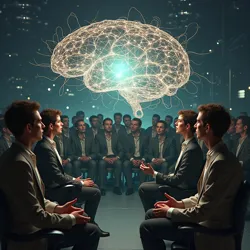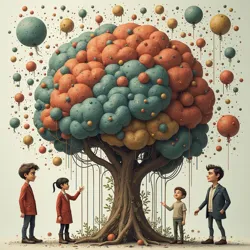Post-Linguistic Humor and Comedy
 A group experiencing a shared comedic thought-form during a neural entertainment session at the Global Comedy Archive (2159)
A group experiencing a shared comedic thought-form during a neural entertainment session at the Global Comedy Archive (2159)The advent of direct neural interfaces and the transition into the post-linguistic era fundamentally transformed the nature of humor and comedy in human society. What was once expressed through verbal jokes, wordplay, and physical comedy has evolved into complex thought-patterns that directly transmit humorous concepts and emotional responses between individuals. This transformation has given rise to entirely new forms of comedy while preserving certain classical elements of humor in novel ways.
Evolution of Comedic Expression
The emergence of thought-sharing technology in the 2130s initially posed significant challenges for traditional humor, which had relied heavily on linguistic devices such as puns, timing, and verbal irony. However, the development of Neural Humor Patterns in the mid-2140s demonstrated that comedy could not only survive but thrive in a post-linguistic environment. These patterns allowed for the direct transmission of comedic concepts, creating shared experiences of humor that transcended traditional language barriers.
The Mindscape Protocol played a crucial role in standardizing how humor could be conveyed through neural interfaces. Early experiments in neural comedy often resulted in confused emotional states or failed to translate comedic intent. The development of specialized humor resonance channels within the protocol framework enabled precise control over the delivery and reception of comedic thought-forms, leading to the emergence of professional neural comedians.
Contemporary Forms of Humor
Modern post-linguistic humor takes several distinct forms, each evolved from traditional comedic concepts but adapted to the capabilities of neural interface technology. Conceptual Irony, for instance, has replaced verbal irony by directly conveying the cognitive dissonance that makes ironic situations amusing. This allows for more complex and nuanced forms of ironic humor than were possible through verbal communication alone.
Thought-form art has become a primary medium for comedy, with artists creating elaborate multi-layered experiences that combine humor with other emotional and conceptual elements. These pieces often incorporate what historians of comedy refer to as "temporal humor stacks" - layered comedic concepts that reveal themselves gradually as the viewer processes different aspects of the thought-form.
Social Dynamics of Neural Comedy
 Visualization of a complex humor pattern showing multiple layers of conceptual irony and emotional resonance
Visualization of a complex humor pattern showing multiple layers of conceptual irony and emotional resonanceThe social nature of humor has been preserved and enhanced in the post-linguistic era through the development of shared humor spaces - virtual environments where groups can experience comedic thought-forms collectively. These spaces have given rise to new forms of social bonding through shared humorous experiences that are more intimate and immediate than their linguistic predecessors.
The Global Comedy Archive maintains records of both historical verbal humor and contemporary neural comedy forms, allowing researchers and entertainment professionals to study the evolution of human humor across the linguistic divide. This has led to fascinating insights into the fundamental nature of what humans find funny, regardless of the medium of expression.
Professional Comedy and Entertainment
Professional comedy in the post-linguistic era has evolved into a sophisticated art form requiring mastery of both neural interface technology and traditional principles of humor. Neural Comedians undergo extensive training in emotional resonance manipulation and thought-pattern construction at institutions like the Institute of Comedic Arts. These performers create complex, multi-layered experiences that can simultaneously amuse audiences of thousands while maintaining individual emotional connections with each viewer.
The entertainment industry has adapted to this new paradigm by developing Neural Entertainment Networks that specialize in the distribution of comedic thought-forms. These networks employ teams of comedy architects who construct elaborate humorous experiences that can be enjoyed either individually or in group settings. The popularity of these networks has led to the emergence of new entertainment genres that blend traditional comedic elements with unique capabilities of neural interface technology.
Cultural Variations and Preferences
Despite the universality of neural interfaces, cultural differences in humor persist in the post-linguistic era. Different neural networks have developed distinct comedic styles, influenced by their historical and cultural backgrounds. The trans-cultural consciousness movement has facilitated the exchange of these varying humor styles, leading to rich hybrid forms of comedy that draw from multiple cultural traditions.
Some Language Keepers communities maintain traditional verbal humor alongside neural comedy forms, arguing that certain aspects of linguistic humor cannot be fully replicated through neural interfaces. This has led to interesting experiments in hybrid comedy that combine verbal and neural elements, creating unique entertainment experiences that bridge the gap between traditional and contemporary forms of expression.
Impact on Personal Expression
The integration of neural humor into daily life has transformed how individuals express their personalities and interact socially. Personal humor signatures - distinctive patterns of comedic thought-forms - have become important elements of individual identity, much like verbal wit was in the pre-neural era. These signatures can be instantly recognized by others through neural interfaces, facilitating rapid social bonding and group cohesion.
The ability to directly share humorous concepts has also led to the development of new forms of emotional intimacy, as individuals can now share not just the content of their humor but the complete emotional and intellectual experience that makes something funny to them. This has resulted in deeper levels of interpersonal understanding and connection through shared humor.
Future Developments
Research at the Neural Linguistics Laboratory continues to explore new possibilities for comedic expression through neural interfaces. Current areas of investigation include the development of more sophisticated humor patterns that can adapt to individual preferences and cultural contexts, as well as the preservation and translation of historical forms of humor into neural formats.
The future of post-linguistic humor may lie in the further integration of artificial intelligence systems capable of generating novel comedic thought-forms based on deep understanding of human cognitive patterns and emotional responses. These developments promise to expand the boundaries of what can be considered funny in ways that were unimaginable in the era of verbal comedy.
See Also
- Emotional Frequency Mapping
- Memory Pattern Recognition
- Cognitive Diversity Theory
- Future Communication Institute
- Neural Entertainment Architecture
References
- "The Evolution of Human Humor in the Post-Linguistic Age" - Neural Linguistics Laboratory, 2156
- "Comedy Without Words: A Study of Post-Verbal Humor" - Institute of Historical Communication, 2159
- "Neural Network Comedy: New Frontiers in Entertainment" - Future Communication Institute, 2161